Walking back home after an Urban Sketchers gathering at the San Antonio church here in San Miguel de Allende, Mexico, this past Wednesday, I came across a dazzling new sight in this city of endless dazzling sights: colorfully tasseled bread baskets seemingly floating in the sky over Relox Street in midtown. Of course I had to stop and take their picture:
After having just spent an hour sketching — trying to tell myself, and train myself, to pay close attention to the subject at hand and really, really see it — I stood beneath these baskets for a long while and wondered, What was I looking at? and Why was it up there? Did it have some sort of religious meaning? What was it celebrating?
Finally, I asked the young Mexican woman in a nearby gallery, “Que significa las canastas sobre la calle?” (What do the baskets over the street signify?), and she informed me, with a slight shrug, “Oh, they’re just for decoration.”
Just, I thought, another colorful, creative, outdoor expression of joyful life here in Mexico.
It was an exceptionally beautiful day. Everyone I spoke with remarked on it, which was unusual, it seemed to me, because beautiful days normally go without saying here. The rainy season was winding down. The reservoir at the Botanical Gardens, which was bone-dry just about six months ago, was now full; and all looked lush and green to me on a recent hike there:
But Wednesday night we got a surprise of biblical proportions. Not long after dark, storm clouds rolled in like an angry invading army, lightning struck in a fiery fusillade, thunder shook the earth and sky, and rain came down with a vengeance for hours.
The wind repeatedly opened then slammed shut my outer screen doors. The rain seeped through the closed windows of my second-floor apartment, creating enlarging puddles on my terracotta tile floors. My evening was spent mopping. By eleven, though, Mother Nature seemed to have had her say. Her wrath had subsided. I went to sleep.
But in the morning on my walk I inspected the damage in the surrounding area. I visited my dentist in a nearby neighborhood and saw that his entire office had been flooded. I saw that a long, tall, cement retaining wall had been knocked over like a child’s toy. I saw people bailing out their ground-floor homes and tiendas (shops). I stepped through a lot of squishy mud.
I live near an arroyo, which is normally a long, winding, boulder-filled gully, not terribly deep or wide, with scant water flowing through it most of the year. But recent rains, especially Wednesday night’s thunderstorm, have strained this arroyo, almost to its limit:
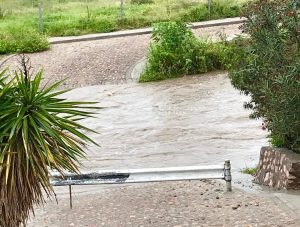
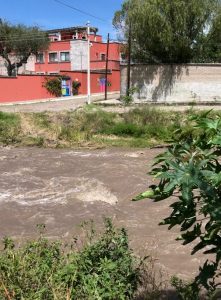
At an altitude of 1,900 meters (6,233 feet), snuggly situated in the central mountains of Mexico, I had thought (wrongly) that the serious flooding caused by the climate change crisis that I’ve read about in the news of elsewhere in the world, was not one of the many things I personally needed to worry about. We’re a long way from sea level here. Little San Miguel de Allende is not to be confused with New York City or New Orleans.
But my Spanish maestra (teacher), Edith, who was born and raised in this neighborhood and who teaches me so much more than Spanish, explained in a recent lesson that there are large bodies of water (lakes and reservoirs, I presumed) higher up in the mountains, which can and do overflow their banks and barriers when there is too much rain. That is, too much rain caused by climate change. Those burst bodies of water could cause this arroyo to overflow and flood this area, Edith told me.
So even here in seemingly idyllic San Miguel, Mother Nature is roaring: Wake up! Listen to me! Pay attention! Open your eyes and SEE! No one is exempt…
On Thursday’s walk I had to return to Relox. I had to see whether the violent storm had torn the hanging baskets from their spidery-fine threads and smashed them to the ground.
Is all hope lost? I wondered.
No, I was relieved to see, it isn’t, quite yet.
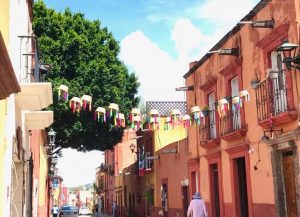
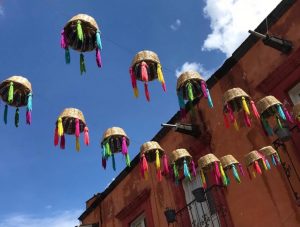


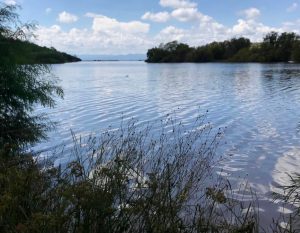
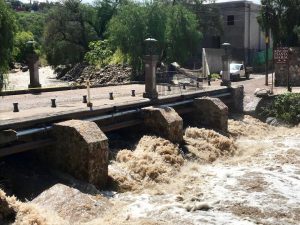
Love this Bonnie! Beautiful how you connected one of San Miguel’s quiet little treasures with la tormenta. Seems San Miguel is not quite as protected from climate change as we have maybe assumed.
Thanks so much, querida Kim! Yes, you certainly get it. I just wonder how many “warnings” dear old Mother Nature is going to give us…
You capture SMA so well.
Thank you, Lyn!
Querida Bonnie, happy to see that the baskets survived la lluvia fuerte.
Muchos hugs.
Si! Gracias, querida Te! I hope all is well with you and Gary. Abrazos fuertes a ti, BB xx
Dear Bon,
The truth is that climate change is here and touching everyone, It’s a situation that can only intensify as long as it’s ignored or merely given lip service. People are desperate for substantive change, but those with power want only money. I agree with you that we must have hope, but even hope needs a powerful ally with deep pockets sometimes.
Your pictures are lovely and make SMA look incredibly beautiful, even in the rain.
Love,
Paul
I SO agree with you, Paul dear. And I realize passive hope is next to useless. So is hand-wringing. The whole situation is agonizing. 🙁
Thank you so much, Bonnie! Great post!! <3
Thank YOU so much, Pam. Glad you liked it.
Amazing story!
Thanks, Lily!
Such a powerful image: the Earth crying out for out attention with thunder, lightening, rain, floods. Can we hear?
Yes, Helaine. And even if we hear, can we — or do we care enough to — do anything about it?
I may be stoned to death for writing my opinion on our current situation of climate change. Yes, our modern-day human additions of CO2 to the atmosphere are increasing the warming of the atmosphere, but, if we do some historical research, we find that “Earth has experienced cold periods (or “ice ages”) and warm periods (“interglacials”) on roughly 100,000-year cycles for at least the last 1 million years. The last of these ices ended around 20,000 years ago. Over the course of these cycles, global average temperatures warmed or cooled anywhere from 3° to perhaps as much as 8° Celsius (5°-15° Fahrenheit). It was partly through their attempts to understand what caused and ended previous ice ages that climate scientists came to understand the dominant role that carbon dioxide plays in Earth’s climate system, and the role it is playing in current global warming.
Over at least the past million years, glacial and interglacial cycles have been triggered by variations in how much sunlight reaches the Northern Hemisphere in the summer, which are driven by small variations in the geometry of Earth’s orbit around the Sun. But these fluctuations in sunlight aren’t enough on their own to bring about full-blown ice ages and interglacials. They trigger several feedback loops that amplify the original warming or cooling. During an interglacial,
• sea ice and snow retreat, reducing the amount of sunlight the Earth reflects;
• warming increases atmospheric water vapor, which is a powerful greenhouse gas;
• permafrost thaws and decomposes, releasing more methane and carbon dioxide; and
• the ocean warms and releases dissolved carbon dioxide, which traps even more heat.
These feedbacks amplify the initial warming until the Earth’s orbit goes through a phase during which the amount of Northern Hemisphere summer sunlight is minimized. Then these feedbacks operate in reverse, reinforcing the cooling trend.”
Source: https://www.climate.gov/news-features/climate-qa/hasnt-earth-warmed-and-cooled-naturally-throughout-history
“There are currently 26 active volcanoes erupting around the world today. According to the U.S. Geological Survey (USGS), there are about 1,500 potentially active volcanoes worldwide, with about 500 of the 1,500 erupting in historical times. Jun 11, 2021”
Source: https://www.google.com/search?client=firefox-b-d&q=erupting+volcanos
No doubt most of you have heard that good old Popocatepetl in Cholula, Mexico has been erupting lately and they have been evacuating people from the surrounding areas.
There is currently no agreement on the effect that volcanic eruptions can have on the atmosphere.
Ian Plimer in his book Heaven and Earth says: “Volcanoes produce more CO2 than the world’s cars and industries combined.” James Randerson challenged Plimer on this point, stating that the US Geological Survey (USGS) states: “Human activities release more than 130 times the amount of CO2 emitted by volcanoes.”
One thing we do know is that volcanic “eruptions are a major source of air pollution. Sulfur oxides released from the volcano react with sunlight, atmospheric gases and aerosols, and convert to fine particles. The resulting volcanic smog, known as vog, is a recognized health hazard.”
Source: https://www.sciencedirect.com/science/article/pii/S2590162118300017
One last thing I have to say is that if you believe in global warming, check out the temperatures in Canada last winter.
“Temperatures – Down They Go
Across North America, February saw the coldest temperatures in more than a quarter of a century. … In early February, for instance, Edmonton endured six consecutive days of high temperatures below -20° C.”
Source: https://www.farmersalmanac.com/canadian-winter-2020-2021-recap
Our friends and family in Edmonton where we’re from were really envious of us being here in Mexico and we loved it.
Wow, Pat! Thanks for taking the time to share all this valuable info with WOW readers. I’m in no position to argue with you, not being a scientist. All I can say is that I respect your point of view, and I appreciate the conversation.
It is great to hear a true explanation from Pat, that I have long believed, but don[t have the knowledge to scientifically express it. Thank you.
Yes, Kaye. I’m happy that we’re all having this conversation!